The Dempster Highway — Epilog
Returned from the Dempster, parked in a snug RV park in Dawson, and reflecting on things a bit. It’s been a long week and a long road. Think of it as driving from San Jose, California, to San Diego, California, by rough dirt road. Then drive back too.
So what’s our overall evaluation? We are very glad that we drove the Dempster, we’re thrilled to have stood at the edge of the Arctic Ocean. We would always regret having gone half-way (or not at all). We are far more knowledgeable about many, many things, for having made the trip. We’d recommend it to anyone in the spirit for that kind of adventure – – – and work. For the Dempster demands work and labor, simply to execute the drive, and later to recover from the ravages of the trip.
DIRT: This is a 914 mile (round-trip) dirt road. Our vehicles were caked with mud, covered with dust, and then covered with another layer of mud. With more rains, the coating was dissolved into sludge, then re-coated with dust and another layer of mud. Throw some rocks, gravel, and road tar into the mix. When we finally exited those 914 miles of Dempster Highway, it took us over an hour with a high-pressure washer just to get the thickest layers washed off. The underbodies are still mucked up.
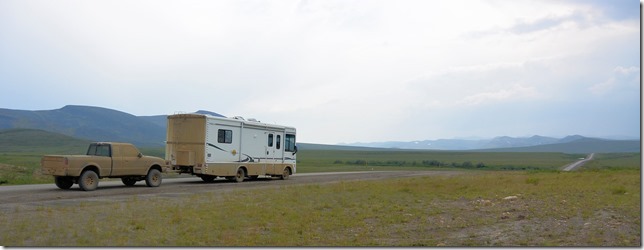
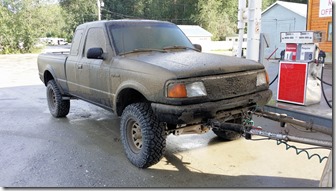
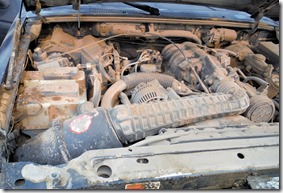
Howie had gained a truly prodigious accumulation of dark-brown road grime, and Ralph, always behind in the cloud of filth, was the worst-treated on the trip. Absolutely every outside surface had an average 1/4 inch of caked grime. He looked liked he’d been sprayed with one of those acoustic-coating spray nozzles. Sadly, this continued throughout Ralph’s entire engine compartment, with buildups of 4-inch thicknesses in the corners and crannies. Radiators, inside the alternator, caked on top of the engine block, you name it. The “mud fog” churning behind Howie simply got anywhere and everywhere, settled in and stayed there.
In addition to the obvious crud, there was a ubiquitous layer of dust on every inside surface. The dust behind Howie had been so ever-present, for so long, that it simply became part of the atmosphere around Ralph, settling and clinging to any solid surface. There was even dust on the inside of Ralph’s dashboard Plexiglas overlay, which will require taking the dashboard apart to clean.
We anticipate that we will still be cleaning up after the Dempster for the next six months, at least – and that’s not a joke or exaggeration.
TRACTION: We met some folks who had traveled on the northern Dempster (above Eagle Plains) during a mild rain. They said it was so slimy and slippery that they returned to Eagle Plains. The rain stopped, and within ONE HOUR the road had dried and solidified enough to be drivable. We have not had as-direct an experience, but we have had many, many experiences over the years with slippery, muddy roads. (One time in Colorado, I thought Ralph had turned into a hockey puck, I had so little control over him.) Better safe than sorry, the saying goes. Parking on the shoulder is better than driving off of it. (If the Dempster had a shoulder, which in most cases it does not <grin>.) When we negotiated it ourselves through multiple thundershowers, it occasionally got a bit tricky, but never so bad that we felt we had to stop. Some fellow campers sent us an email about their trip down a couple of days before us. They had 100-foot visibility, 6-inch-deep mud, and traveled for almost 100 miles in 4WD at 20mph. This was a section of road we traveled mid-way: dry and dusty until the next rise, then sopping wet from a passing thundershower. Slippery going uphill, treacherous going downhill.
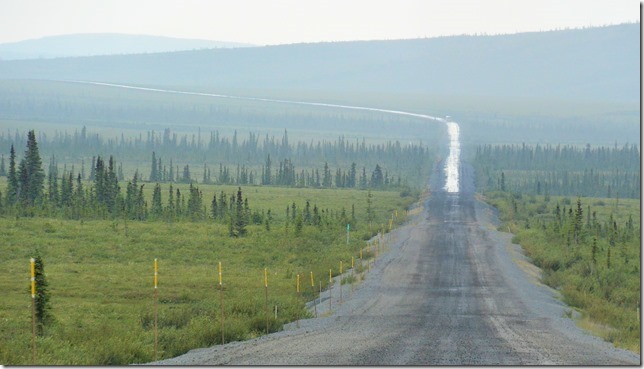
Even when dry, the roughness of the road can create traction issues. In turns or on heavily-rounded crowns, ruts, ripples, washboard and potholes can bounce tires completely clear of the road surface, with zero traction for those moments spent in the air. A really good set of shock absorbers, or (like Howie) double shocks are good insurance to stay on the road over the rough spots.
ATTENTION: This is not a road to take lightly, and constant focus is required. I needed to religiously watch for rough spots, ripples, washboard and potholes every mile of the way. In addition, the shoulders are not only narrow and soft, but incredibly steep, over 45 degrees. Getting a tire over the shoulder is almost a guaranteed crash. One poor woman did exactly that up north of Eagle Plains, and her sad camper and truck were there for several days in mute testimony to the warning, PAY ATTENTION!
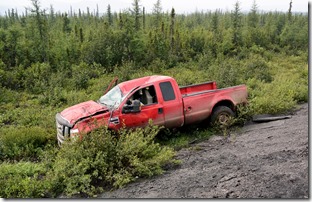
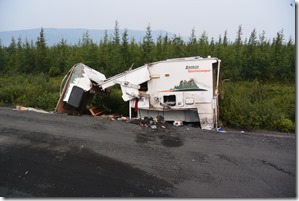
SHAKES and RATTLES: There is simply no adequate way to describe the bashing taken by Howie’s suspension, frame, and cabin. Because the road is often smooth, speeds can get very reasonable – 90kph/56mph is very common. Under many road conditions, it’s very hard to spot roughness or potholes in advance, and sometimes the first evidence is a SLAM!!! as the wheels bounce up against the suspension stops and the chassis takes a massive sledge-hammer hit from the bump stops. At one time or another, pretty much everything that wasn’t screwed, taped, or strapped down went flying through the cabin in lovely parabolic arcs.
The only defense for this sort of thing is to drive the whole distance at 20mph or so, and even this is horribly imperfect. Firstly, at those speed ranges, Howie’s already-horrible fuel economy (7mpg) drops below 4, and we can’t carry enough fuel for the longest leg. Secondly, higher speeds can help skip across the tops of some types of bumps, and lower speeds can actually worsen the ride.
CAMPSITES: There is no boondocking of any kind along the Dempster. Several areas looked a little like they could be over-nighted in, but when we asked, we were assured the situation was ‘no’. Gravel pits and pull-outs are expressly forbidden, and who’d want to stay there anyway? So it’s always necessary to find a formal camp site to spend the night. [Note: at Fort McPherson, the mounties told us we could park pretty much anywhere there was a flat spot in the town. Very unusual and very appreciated, although we elected not to make use of it.] Campgrounds are nicely situated, usually near a stream or river, and placed reasonably well along the highway; the longest stretch is only around 100 miles between camps. Unusually (for us), a large tour-group of twelve RV’s was driving the Dempster at the same time we did. We ran across them repeatedly in various camp sites, and exchanged the usual traveling “war stories”. It’s a pleasant thing to do, and we usually find easy, friendly conversations along the road. But with such a large group, and the relatively small camps along the Dempster, available sites were quickly consumed. At Tombstone, we found no sites available, and had to make a special arrangement with the visitor center. At Rock River (where we did not stay), that group used up 12 of 15 sites. Here’s one of our nicer settings, at the Happy Valley camp in Inuvik, looking back on Howie from the riverbank.
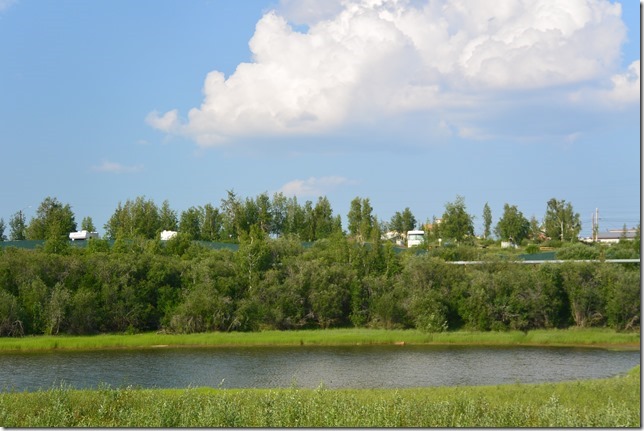
FLATS: We were warned by several sources about the hard treatment our tires would get on the Dempster. In particular, chip-shale was a “razor sharp” culprit that accounted for many a flat tire. We met a highway worker at a rest stop, and he advised us that the road had only a short section remaining of the crummy rock, but that the Rock River camp was very risky, and we shouldn’t go there. [We walked that camp later and found it to be harmless.]
The big group I mentioned made the same trip, same days, same road. Their trip, with perhaps a total of 100 tires amongst them, experienced a total of two flat tires in each direction (4 total). Their vehicles were quite varied, and I didn’t find out whether the flats were smaller/lighter or larger/heavier tires. Would’ve been nice to know… Later, I spoke with a tire-repair facility in Dawson. Their experience is that “P” series tires (passenger cars) get the lion’s share of flats. “LT” series (light truck) and regular truck-series tires have heavier construction, and are rarely punctured by rocks.
BREAKDOWNS: After the heavy compilation of dirt, dust and grime, Ralph had an alternator failure. I couldn’t determine the cause — it may have been coincidental, and could have been dirt/grime related. For reasons yet to be determined, Howie has had one leveling jack (of 4) quit operating. Ralph’s hood latch went non-op until I doctored it back into functionality, and all of Howie’s cargo door latches needed careful cleaning and lubrication. In addition, Howie’s supplemental brake warning light has started acting up, half-on all the time. And after driving Ralph for a few miles, it’s clear that the brakes are dragging, and have been clogged up somewhere with mud and crud. Into the shop on Saturday, to find that the rocks and dirt had wormed their way into the front grease seals, destroying the inner wheel bearings. The wheel/brake assemblies were so hot we had to use rags to take things apart.
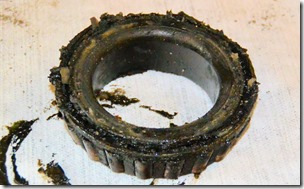
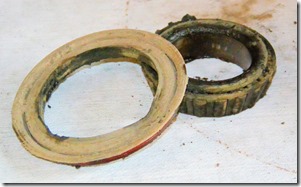
That’s just the initial survey. The huge buildup of crud is likely to take its toll on other components in the near future. In short, the road is much more costly per mile than typical paved travel. And we have re-learned what we already knew: be prepared for systems to quit. You never know what will stop working, only that it will be something. This gets us to the most essential ingredients for successful travel on the Dempster, or anywhere for that matter: Extra water, gas, some parts and tools, a resident handy-man (me), and the time and attitude to deal with any problems that come along. And I will likely do a quick visual on my toad each time we stop, especially on rough roads.
MILEAGE: The long stretch on the Dempster is 229 miles between gas stations. With Howie’s puny 40-gallon tank, and his average 7 miles per gallon, it was a little bit of a risk – we took along spare gas. BUT – and it’s a big ‘but’ – Howie only gets that 7mpg when he’s doing 45mph or so in top gear. Anything slower drops down into the lower gears, and 4mpg is what I typically see on the gauge at 30mph. Consequently, going slow not only takes longer, but uses more gas. This is always something I keep in mind when I’m negotiating slow or rough roads.
MOSQUITOES: In Dawson, mosquitoes are a minor annoyance. In our previous camp south of town, near the airport, they were occasionally impressive, but not anything to brag about. However, as we traveled north, the mosquito population seemed to grow with every mile. Eventually, it reached epic proportions. Often, we’d get out of Howie and be instantly swarmed by literally hundreds of zooming bloodsuckers. At Tombstone, it was manageable, but again, as we traveled north, we would routinely get 10-20 mosquitoes inside Howie just by opening and closing the door. We spent an hour one morning finding “leaks” in Howie, and we made good use of an electronic bug-swatter we bought (almost as a joke). For $7, this was some of the best money we spent. Everything — jackets, swatters, repellents, etc. — are only partially effective. If you live in mosquito country, you’re going to get bitten. It’s just a matter of how much. [I read an article on the caribou up on Alaska’s north slope, where a weak animal can actually be killed by mosquitoes, which will extract a QUART of blood, or more, in a single day.]
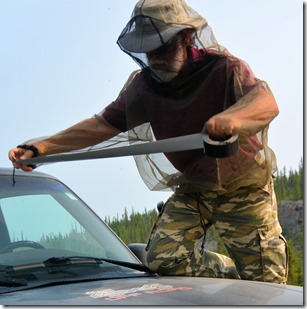
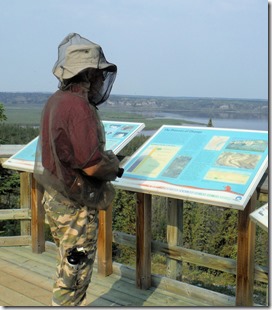
WILDLIFE: Unfortunately, this is the topic that I have the least to write about. For the entire length of this remarkable road, there was simply nothing but birds, rabbits, and squirrels to be seen. A marmot at Tombstone was a real high point. We’ve been told that the caribou are easily spotted during their migration – in September, unfortunately for our June trip. We talked to other folks that saw a moose and calf at Two Moose Lake (how poetic). And someone saw a distant grizzly at Inuvik’s Jak Park campground. But overall, wildlife was simply a non-event for us.
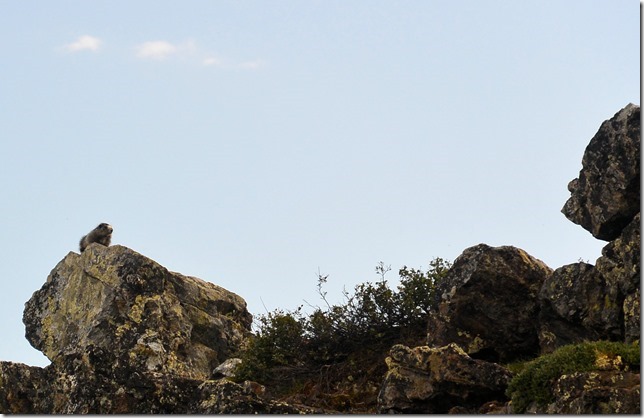
INTERNET: As wonderful as this vast wilderness is, we occasionally need to contact friends, family, or deal with financial concerns, and the Internet is the pathway of choice for all of us. The Canadian northwest level of Internet is fairly primitive compared to what I’m used to in Comcast-cable Silicon Valley. And its availability is extremely limited, in both location, accessibility, and bandwidth. Furthermore, all these shared wifi networks always seem to have somebody Skyping or wifi-calling, using up the skimpy bandwidth that is available. For the Dempster, we found mediocre wifi at the Dawson visitor center; similar at Eagle Plains Hotel for $5/day; and good wifi but limited to two hours a day at Inuvik public library. That was it, and we had to live with it. The few blog posts I was able to upload took 10-20 tries, and at least a half-hour to complete. For absolute emergency communications (short texts or emails), I carry the DeLorme InReach GPS communicator. This wonderful gadget is 100% reliable as long as it can see some sky. I’ve only had it not connect when I was in deep, deep forest cover, and even then I could walk out into a clearing and get connected.
LESSONS LEARNED: Don’t take Howie on muddy roads, and especially don’t tow Ralph under those conditions. Dirt and dust are one thing, and they fall off and blow away fairly quickly. Clean up is fairly easy. Mud sticks and stays with you to the bitter end. Really wet mud forms a “fog” behind Howie, and it seeps into every nook and cranny of Ralph’s body, engine compartment and running gear. I need to check the status and condition of Ralph more often; I do have tire pressure sensors, but they won’t tell me if the wheel bearings are melting down. I need to be “chilled out” and flexible. Breakdowns are a little intimidating when we are 3,000 miles from “home”, but let’s face it, nothing lasts forever and repairs are just a part of life, either at home or on the road. Travel is easier and more relaxing if we just “roll with the punches”, and keep on truckin’.

Good trip report and glad you enjoyed the road. We’ve been on the Dempster 7 times now and will return next year to drive it’s extension to Tuktoyaktuk. I’m of the opinion that a Class A or long motorhome is a poor choice for driving this road … their suspensions are often not built durable enough for rough road travel. Being large and long is probably also why you had difficulty locating boondocking spots … if you drive a truck camper (as we do), boondocking possibilities are endless.
Dann,
Thanks for the comments. Yes, not only is the long rig a hassle in finding boondock sites, but it also kicks up a lot of “mud fog”, which caused huge problems on my toad, with many $$$ in repair expenses. I’m not sure how we’d do it the next time. Maybe just take the toad and rent rooms at Eagle Plains and Inuvik. We’re way too fond of the motorhome (only 27′) to trade it for anything else. :o)
We travelled the road ONCE with just a 3/4 ton van, boats, hiking gear and a tent. We dumped our travel trailer in Whitehorse. No reason why you wouldn’t have a good trip with just your Toad and some basic camping gear.
Well……….
We’ve done a LOT of tent camping in our time. But now, in our 70’s, creature comforts mean a lot. We remember a night south of Inuvik (Caribou Campground) when we thought the mosquitoes were going to carry away the motorhome. We shudder to think what a tent experience would have been. :o)
We’re still thinking it through. Not sure when we’re going back, but we did surely love it.
Well …
If you are interested … we will be on the road next year. We will be there with mostly truck camper rigs. We have initiated a FB Group called Canadian Truck Camper Owners Group and we have a personal website/blog http://LOAFin-Around.blogspot.ca if you are interested in joining us. Stay Safe!
For the love of all sanity.. Buy a fishing pole and a beer cooler, join us in Normalville you crazy kids x
Great blog and very good pictures.I have traveled the states in motor home but never so far north.You guys are much braver than me! I really like the writing and descriptions of every thing.Cant wait for the next blog. Keep on trucking!—–John L.
Greg,
Thank you so much for the great commentary and photos. My wife and I have only been camping in our travel trailer for the last year and a half. You have taken us on a trip we will never do, but reading your posts has given us a flavor for the place and the people – worthy of National Geographic. You guys are very resourceful and courageous. God bless you both.
Greg, You have great attitude in the face of so much adversity. Although I like to think that someday I may visit some of the out of the way places you go to, I am afraid that this is one that never will be on my list. Good luck on the rest of your trip.
Pete
Great stories Greg and Karen..so now up to Fairbanks( some civilization).
Is not flying easier and less expensive?
kidding,this is quite an adventure what you guys are doing..
keep the stories and pics coming..
and happy 4th..
tony and marlene
Hello my Friend,
Lewis and Clarke would have loved to have you on their expedition! Great and informative commentary. What an adventure. Give our love to Karen.
Godspeed,
Robert and Barb
PS Happy Fourth!
Robert, they had to work way too hard for me :o)
Soft bed and a hot shower — that’s my speed.
I enjoy your blog and admire you both for your adventurous spirit. I personally would probably not undertake a trip like this but I certainly enjoy living it through you. Looking forward to more of your posts. Thanks